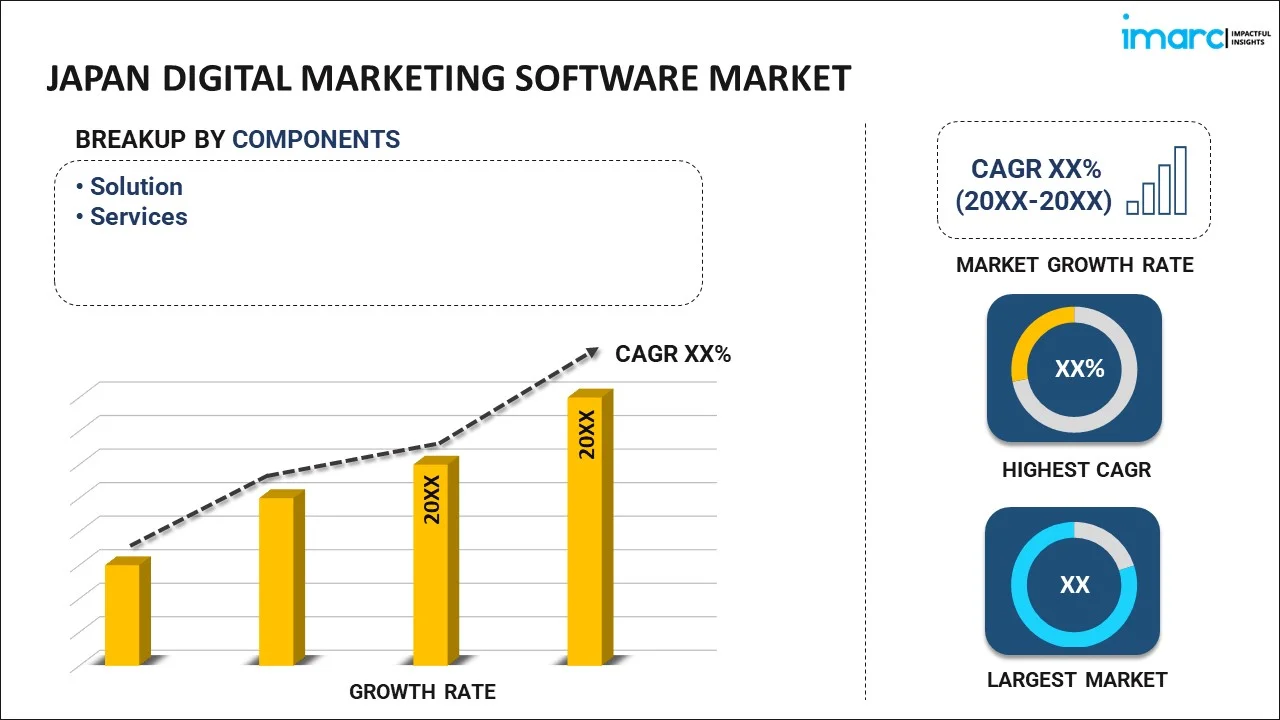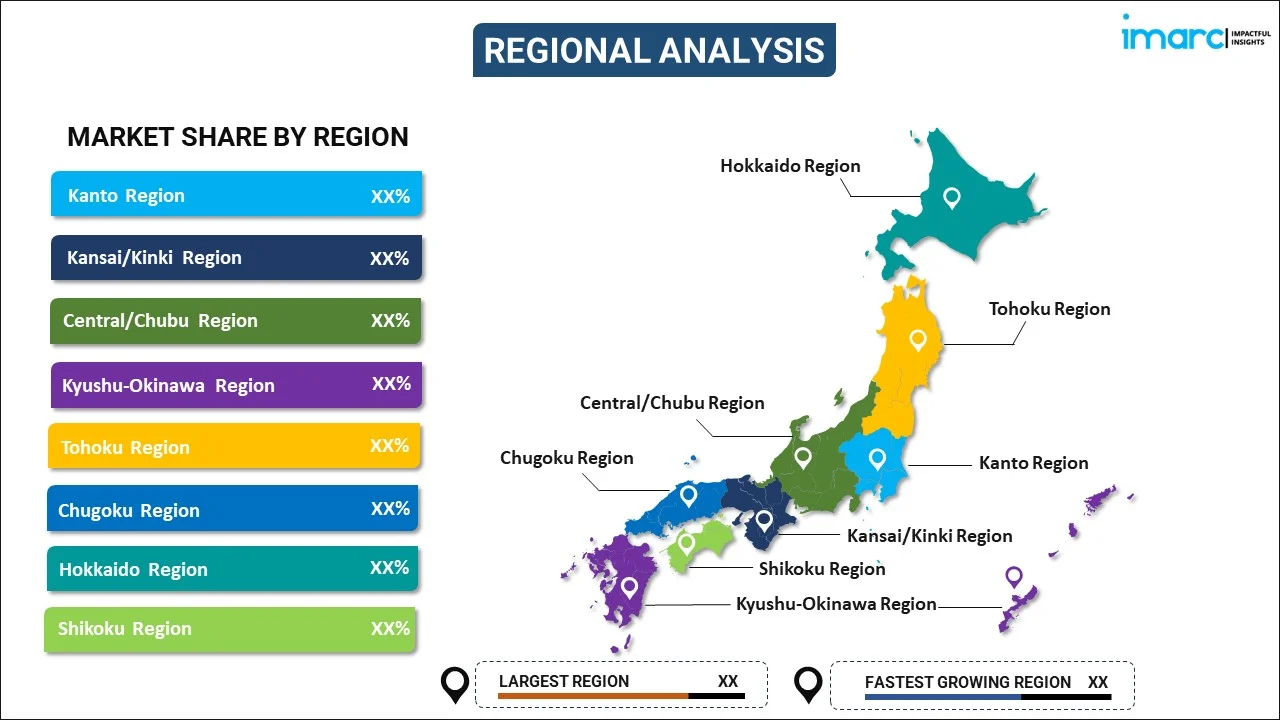
Japan Digital Marketing Software Market Report by Component (Solution, Services), Deployment Type (On-premises, Cloud-based), Organization Size (Large Enterprises, Small and Medium-sized Enterprises), End Use (Media and Entertainment, Manufacturing, Retail, BFSI, Information Technology, Healthcare, and Others), and Region 2025-2033
Market Overview:
Japan digital marketing software market size reached USD 4.8 Billion in 2024. Looking forward, IMARC Group expects the market to reach USD 14.2 Billion by 2033, exhibiting a growth rate (CAGR) of 11.78% during 2025-2033. The market is experiencing growth primarily due to the expanding utilization of voice-activated devices and virtual assistants and the growing dependence of individuals on online shopping platforms.
|
Report Attribute
|
Key Statistics
|
|---|---|
|
Base Year
|
2024
|
|
Forecast Years
|
2025-2033
|
|
Historical Years
|
2019-2024
|
| Market Size in 2024 | USD 4.8 Billion |
| Market Forecast in 2033 | USD 14.2 Billion |
| Market Growth Rate 2025-2033 | 11.78% |
Digital marketing software is specifically crafted to simplify and enhance diverse facets of online marketing and advertising initiatives. It includes a broad array of software applications that assist companies in strategizing, implementing, monitoring, and assessing their digital marketing endeavors across multiple online channels and platforms. This software streamlines marketing activities, leading to time and resource savings through task automation and workflow optimization. It empowers businesses to pinpoint particular demographic groups, interests, and behaviors, heightening the pertinence of their marketing communications. Additionally, it simplifies the development and supervision of email campaigns, encompassing personalized messaging, A/B testing, and the monitoring of campaign performance.
Japan Digital Marketing Software Market Trends:
The Japan digital marketing software market is experiencing significant growth driven by several key factors. First and foremost, the increasing digitalization of consumer behavior has transformed the marketing landscape. With more people relying on the internet for information, entertainment, and shopping, businesses in Japan are keen to leverage digital marketing software to effectively reach their target audiences. Additionally, the proliferation of smartphones and high-speed internet connectivity has made it essential for companies to have a strong online presence, further fueling the demand for digital marketing tools. Furthermore, the COVID-19 pandemic accelerated the shift to digital channels as traditional marketing avenues were disrupted. Companies turned to digital marketing software to engage with customers in a remote and efficient manner. This trend is expected to continue as businesses recognize the importance of digital strategies in a post-pandemic world. Moreover, the Japan digital marketing software market benefits from advancements in technology, including artificial intelligence and data analytics. These innovations enable companies to personalize their marketing efforts, track campaign performance in real-time, and make data-driven decisions to optimize their strategies. Lastly, the integration of cloud-based solutions with digital marketing software is gaining prominence, offering cost-effective and scalable options for businesses of all sizes. As a result, the Japan digital marketing software market is poised for continued growth and innovation in the coming years.
Japan Digital Marketing Software Market Segmentation:
IMARC Group provides an analysis of the key trends in each segment of the market, along with forecasts at the country level for 2025-2033. Our report has categorized the market based on component, deployment type, organization size, and end use.
Component Insights:

- Solution
- Customer Relationship Management (CRM)
- Email Marketing
- Social Media
- Search Marketing
- Content Management
- Marketing Automation
- Campaign Management
- Others
- Services
- Professional Services
- Managed Services
The report has provided a detailed breakup and analysis of the market based on the component. This includes solution (customer relationship management (CRM), email marketing, social media, search marketing, content management, marketing automation, campaign management, and others) and services (professional services and managed services).
Deployment Type Insights:
- On-premises
- Cloud-based
The report has provided a detailed breakup and analysis of the market based on the deployment type. This includes on-premises and cloud-based.
Organization Size Insights:
- Large Enterprises
- Small and Medium-sized Enterprises
A detailed breakup and analysis of the market based on the organization size have also been provided in the report. This includes large enterprises and small and medium-sized enterprises.
End Use Insights:
- Media and Entertainment
- Manufacturing
- Retail
- BFSI
- Information Technology
- Healthcare
- Others
The report has provided a detailed breakup and analysis of the market based on the End use. This includes media and entertainment, manufacturing, retail, BFSI, information technology, healthcare, and others.
Regional Insights:

- Kanto Region
- Kansai/Kinki Region
- Central/ Chubu Region
- Kyushu-Okinawa Region
- Tohoku Region
- Chugoku Region
- Hokkaido Region
- Shikoku Region
The report has also provided a comprehensive analysis of all the major regional markets, which include Kanto Region, Kansai/Kinki Region, Central/ Chubu Region, Kyushu-Okinawa Region, Tohoku Region, Chugoku Region, Hokkaido Region, and Shikoku Region.
Competitive Landscape:
The market research report has also provided a comprehensive analysis of the competitive landscape. Competitive analysis such as market structure, key player positioning, top winning strategies, competitive dashboard, and company evaluation quadrant has been covered in the report. Also, detailed profiles of all major companies have been provided.
Japan Digital Marketing Software Market Report Coverage:
| Report Features | Details |
|---|---|
| Base Year of the Analysis | 2024 |
| Historical Period | 2019-2024 |
| Forecast Period | 2025-2033 |
| Units | Billion USD |
| Scope of the Report | Exploration of Historical and Forecast Trends, Industry Catalysts and Challenges, Segment-Wise Historical and Predictive Market Assessment:
|
| Components Covered |
|
| Deployment Types Covered | On-premises, Cloud-based |
| Organization Sizes Covered | Large Enterprises, Small and Medium-sized Enterprises |
| End Uses Covered | Media and Entertainment, Manufacturing, Retail, BFSI, Information Technology, Healthcare, Others |
| Regions Covered | Kanto Region, Kansai/Kinki Region, Central/ Chubu Region, Kyushu-Okinawa Region, Tohoku Region, Chugoku Region, Hokkaido Region, Shikoku Region |
| Customization Scope | 10% Free Customization |
| Post-Sale Analyst Support | 10-12 Weeks |
| Delivery Format | PDF and Excel through Email (We can also provide the editable version of the report in PPT/Word format on special request) |
Key Questions Answered in This Report:
- How has the Japan digital marketing software market performed so far and how will it perform in the coming years?
- What has been the impact of COVID-19 on the Japan digital marketing software market?
- What is the breakup of the Japan digital marketing software market on the basis of component?
- What is the breakup of the Japan digital marketing software market on the basis of deployment type?
- What is the breakup of the Japan digital marketing software market on the basis of organization size?
- What is the breakup of the Japan digital marketing software market on the basis of end use?
- What are the various stages in the value chain of the Japan digital marketing software market?
- What are the key driving factors and challenges in the Japan digital marketing software?
- What is the structure of the Japan digital marketing software market and who are the key players?
- What is the degree of competition in the Japan digital marketing software market?
Key Benefits for Stakeholders:
- IMARC’s industry report offers a comprehensive quantitative analysis of various market segments, historical and current market trends, market forecasts, and dynamics of the Japan digital marketing software market from 2019-2033.
- The research report provides the latest information on the market drivers, challenges, and opportunities in the Japan digital marketing software market.
- Porter's five forces analysis assist stakeholders in assessing the impact of new entrants, competitive rivalry, supplier organization, buyer organization, and the threat of substitution. It helps stakeholders to analyze the type of competition within the Japan digital marketing software industry and its attractiveness.
- Competitive landscape allows stakeholders to understand their competitive environment and provides an insight into the current positions of key players in the market.
Need more help?
- Speak to our experienced analysts for insights on the current market scenarios.
- Include additional segments and countries to customize the report as per your requirement.
- Gain an unparalleled competitive advantage in your domain by understanding how to utilize the report and positively impacting your operations and revenue.
- For further assistance, please connect with our analysts.
 Inquire Before Buying
Inquire Before Buying
 Speak to an Analyst
Speak to an Analyst
 Request Brochure
Request Brochure
 Request Customization
Request Customization




.webp)




.webp)












